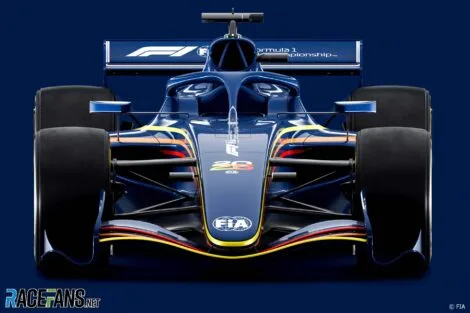The FIA has unveiled its first look at the intended technical regulations to be introduced into Formula 1 from 2026.
The 2026 season will see the introduction of revised 1.6-litre V6 hybrid power units and also major changes to the cars themselves, which the governing body have detailed publicly for the first time today.
Featuring a 30kg minimum weight reduction from the current regulations to 768kg, a wheelbase reduction of 200mm and an overall maximum width reduction of 100mm, the next generation of F1 cars will be lighter, shorter and slimmer than current cars. However they will still be heavier than those raced in 2021.
Formula 1 cars will continue to use ground effect aerodynamics to generate downforce, however overall downforce will be reduced by around 30%. Active aerodynamics will become a major feature of the upcoming cars, with drivers able to change at will between multiple configurations while on track – ‘Z-mode’ for higher downforce and ‘X-mode’ for lower downforce and lower drag. The FIA expect the new cars to have a drag reduction of under half of current levels.
Revisions to ground effect-generating floors, making them flatter and reducing the downforce generated by rear diffusers, are intended to improving ride quality for drivers by encouraging teams away from extremely stiff suspension settings and ultra-low ride heights. Front wings will be narrower than currently by 100mm. The wheel arches introduced in 2022 are to be removed entirely but new compulsory bodywork has been specified to make the wake produced by wheels less disruptive for a chasing car.
F1 will continue to use the 18-inch wheels which were introduced two years ago. However, wheel sizes are being reduced by 25mm on the front axle and 30mm on the rear, which the governing body claims will be achieved without a significant loss of tyre grip.
The sport’s new power units will have far greater power generated – almost 300% more – by electrical components despite the removal of the MGU-H from current specifications and will run on “fully sustainable” fuels. With the removal of the Drag Reduction System, the sport will replace the overtaking aid with a new ‘manual override mode’, which will allow chasing cars the ability to use greater electrical output at speeds above 290kph, while leading cars will have their electrical power gradually reduced once beyond the…
Click Here to Read the Full Original Article at RaceFans…

